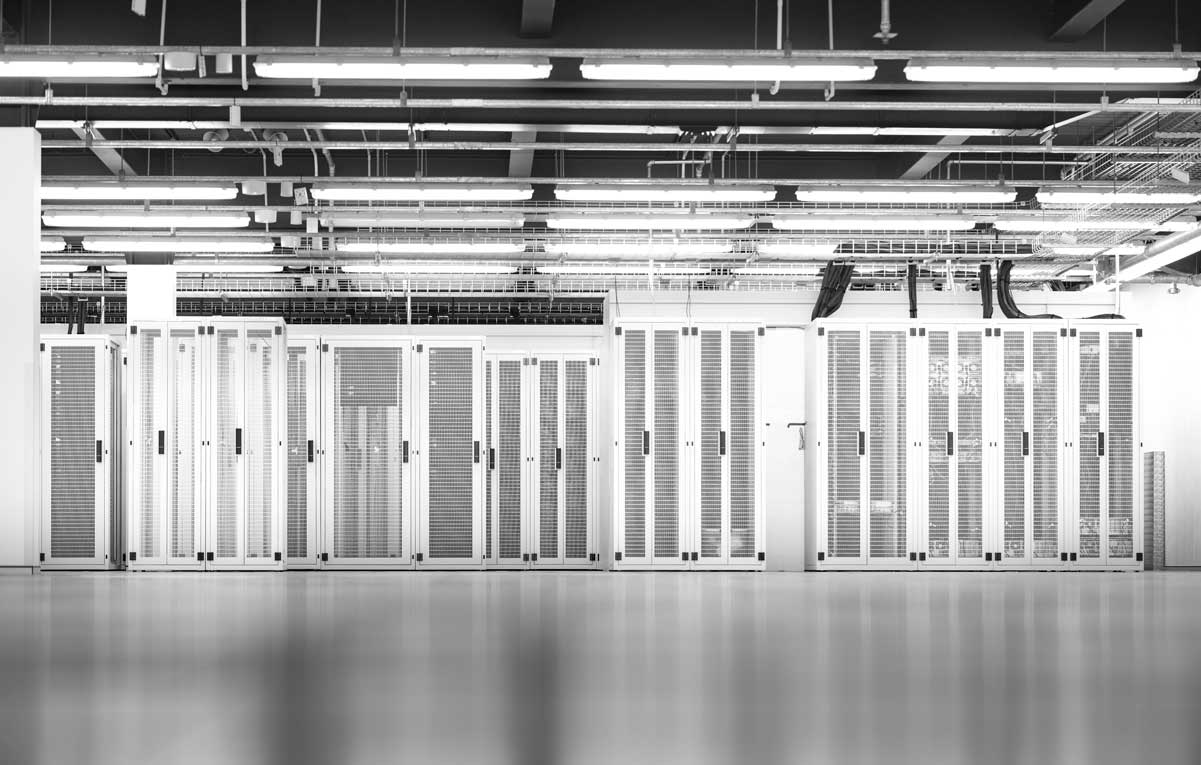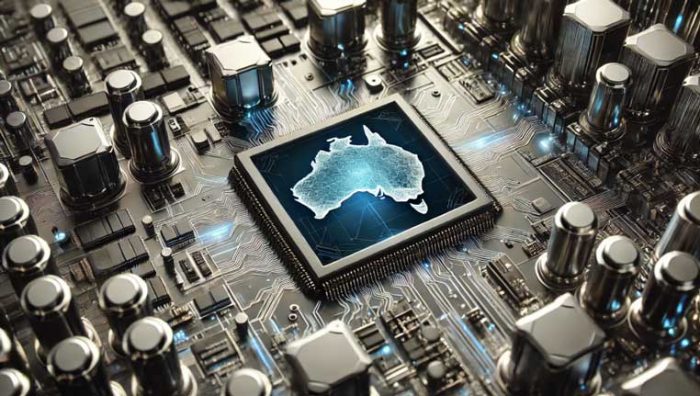What is an AI data centre, and how does it work?

Artificial Intelligence and machine learning are extremely proficient at finding patterns in data. They solve problems at previously unfathomable speeds and all but eliminate the potential for human error when exploring complex data sets.
They’re so powerful in fact, that 64-69% of the total time spent on data collection and processing can be automated with AI, according to McKinsey.
But this raises concerns. While AI is powerful, it’s also resource-intensive. AI adoption is becoming the new norm, and the more we deploy AI workloads to streamline business operations, the more resources we need to keep up.
Due to the high resource needs of AI workloads, AI models can only live in data centres, but not just any data centre, AI data centres. This means re-engineering data centres to an entirely new AI data centre. Keeping up with AI means higher rack densities, innovative and hybrid cooling, and a greater need for power.
AI data centres can handle the vast resource demands that artificial intelligence places on businesses looking to use AI to their advantage. In this article, we’ll explain why it’s important and how it works. But let’s start with the basics by looking at what an AI data centre is.
What is an AI data centre?
An AI data centre is a facility designed to cope with the enormous power, storage and cooling requirements of AI technology. It contains unprecedented computing resources to handle the resource-intensive training and deployment of complex machine learning models and algorithms.
Book a data centre tour Read more about our AI Solutions
Why do data centres need to adapt to the evolution of AI?
AI is responsible for a 10x increase in resource requirements compared to the cloud. The resource needs of AI workloads are just too great to run on-premise data centres or in-house as you will not have the power, cooling or redundancy to manage this efficiently. Compared to the cloud, AI training and inference can become super costly as you grow.
Beyond this, deploying AI models for real-world applications is becoming nothing short of a necessity. Running trained models on production servers can facilitate facial recognition or translate between languages in an instant.
AI algorithms can even improve workload management and resource allocation or support security and compliance measures by proactively detecting anomalies.
The benefits of AI models aren’t exhaustive. However, training and deploying these workloads demands enormous computing power, which in turn demands vast computational resources. This leads us to why this type of data centre is so important.
Why do we need AI data centres?
Many businesses still keep their cards close to their chest by maintaining a single traditional on-premises facility to process and store data for day-to-day tasks. Whilst this may serve the purpose for traditional workloads, high-density computing & AI workloads require vastly more power & cooling.
We can (admittedly simplistically) break down the process of building an AI model into four phases.
- Find the problem: Identify specific business problem the AI platform needs to solve
- Preparation: Datasets are gathered and optimised to be fed into the AI.
- Training: The AI is taught to learn patterns and perform a task by being exposed to enormous amounts of collected data.
- Inference: The AI makes real-world predictions and decisions based on unseen data.
Specifically, helping an AI model learn and refine its parameters based on datasets requires previously unfathomable power requirements and cooling systems.
Traditional (often on-premises) CPU-powered data centres have doubled in power in the last year. They now have an average density of around 12 kilowatts (kW) per rack.
That might sound substantial, but AI can demand well over 60kW per rack. Data centre architecture must now be designed specifically to accommodate this. High-density servers, innovative networking infrastructure and, of course, advanced cooling are all but essential.
As such, many businesses are now beginning to migrate from on-premises servers, instead relying on colocation data centres with advanced capabilities. Let’s now look closer at what those capabilities entail.
The components of an AI data centre.
We’ll broadly break down these data centres into four pivotal components.
High-performance computing resources.
AI data centres replace CPU-powered racks with high-power servers. These servers have advanced hardware like GPUs (circuits that make image and graphic rendering faster) and TPUs (circuits that accelerate AI and ML workloads).
Enormous data storage systems.
They contain scalable and high-performance storage solutions to store and facilitate access to the enormous amounts of data needed for developing and deploying AI models.
Networking infrastructure.
AI demands efficiency and relies heavily on parallel processing. Advanced GPUs and TPUs must be linked with low-latency, high-speed networking to facilitate this and minimise tail latency.
Cooling systems.
Traditional data centres usually rely on air cooling. This doesn’t cut it for the heat AI workloads generate.
GPUs can take on more computing, therefore more kilowatts per rack. The math suggests that air becomes inefficient at around 40kw racks, which is why modern data centres have hybrid cooling options that use liquid cooling.
Liquid cooling is an innovatie new cooling solution which uses a non-corrosive, non-conductive liquid to more efficeinctly and more sustainably cool IT infrascture.
What are the features and benefits?
AI data centres offer a number of tangible benefits for businesses, such as the physical security of AI models and, therefore, an organisation’s intellectual property, improved operational efficiency, and more opportunities for scalability, to name a few.
Let’s take a look at these benefits in a bit more detail.
1. Physical security of IP and AI workloads.
Data centres are designed to be impenetrable fortresses for your intellectual property, but this is especially crucial for AI workloads as well.
If you consider what companies are using to train their AI models, it’s usually confidential company data. So, using an open AI solution isn’t really an option. Data centres offer a practical solution for securing the company’s crown jewels.
This typically includes advanced access control systems, 24/7 surveillance, and robust security measures to ensure your sensitive data cannot be accessed by unauthorised parties.
2. Faster AI training and deployment of AI models.
AI models will soon become a vital tool for modern businesses. Unlike traditional IT workloads, traditional data centres cannot deliver the power needed to train and deploy these models at scale.
With Moores’s Law in full effect, AI data centres cater to the growing computer needs and scale required to speed up the process of training and deploying AI models, bringing several benefits to businesses.
- Improved problem solving: AI data centres enable AI workloads, leading to potential efficiency and productivity gains for organisations. This allows industry specialists to prioritise research and strategic initiatives that drive business growth and create better customer experiences.
- Future-proof infrastructure: For organisations committed to long-term growth, data centres offer scalable and future-proof IT infrastructure ready to take advantage of emerging technologies.
- Agility: Data centres provide customers with (almost) endless space and power so they can ramp up from 7kw to 100kws of computing in less than an hour if need be. If this were to happen with an in-house server room, it could cause a blackout to the whole building.
3. Improved efficiency and accuracy of AI applications.
AI can handle almost all the data wrangling that formerly bogged down a data scientist’s daily workflow. It can even facilitate real-time analytics, leaving more time for experienced analysts to solve complex problems in the context of an industry.
Superior GPU/TPU-powered servers and advanced networking infrastructure mean businesses can create more reliable and accurate applications.
Benefits this offers include:
- Real-time decision-making: AI data centres power AI models to explore datasets and extract business insights quickly and accurately, letting businesses benefit from informed real-time decision-making.
- Predictive analysis: Improved accuracy and efficiency mean AI models can make justifiable predictions in real-time. This helps organisations identify opportunities and risks proactively.
- Efficiency: By automating manual processes, companies can become more efficient and reduce human error and effort.
4. Scalability to handle large and complex AI workloads.
Building and deploying AI models is already a business necessity, but AI is still only in its infancy—there’s more to come. AI data centres offer scalability to cope with these further evolutions.
- Opportunities for scalability: AI data centres easily accommodate increasing volume and complexity as businesses expand their AI initiatives.
- Future-proofing: One of the biggest AI question marks is how it will evolve and shape the world of tomorrow. AI data centres are a long-term investment that offers the scalability to adapt as AI workloads grow in complexity.
- Resource allocation: The AI data centre lets businesses dynamically shift resource allocation to adapt to shifting priorities. Businesses aren’t limited to the capacity of their critical infrastructure on-premises. If they need more resources for different stages of generative AI development, the AI data centre can provide it for them.
5. Improved cost and sustainability.
Running computer-intensive workloads in the cloud comes at a cost. Take Google’s AI Gemini, for example. Each training run is reported to cost 191M, and that’s just one AI in a single company (albeit a big one).
With such intense costs associated, this then begs the question of sustainability. Data centres are the most efficient way to balance cost and sustainability in this growing market.
6. Maintaining compliance.
Does your organisation need to meet certain compliance thresholds? If so, AI data centres offer a significant advantage as they have this built-in.
It’s common for data centres to observe industry standards like HIPAA, PCI DSS, and GDPR. These standards make sure your data is handled securely and according to regulations, which can save you money, time and a potential headache down the road.
Real-world examples of companies moving to AI data centres
Many large and innovative companies are setting their sights on the AI data centre, including:
- Google: Google has poured billions into its AI data centres to support its AI products, such as Google Search and Google Assistant. The centres use custom TPUs to accelerate workloads.
- Nvidia: Nvidia delivers next-generation architectures for GPUs, DPUs, and CPUs. The Blackwell GPU, for instance, offers six transformative technologies to support AI data processing, training, and deployment.
- Tesla: Tesla’s AI data centres are the driving force behind its automatic cars. This technology relies on AI algorithms to analyse data and make real-time decisions.
- Alibaba: This powerhouse in the Chinese e-commerce market has constructed an enormous network of AI data centres to support its services. Alibaba also intends to build new data centres prioritising sustainability.
Notably, we’re yet to see any major healthcare players take the leap, likely due to the sensitive nature of compliance and data sovereignty in the industry.
Still, it’s not unlikely that many will begin to see the benefit of making the switch, especially with the tangible benefits AI can bring to healthcare organisations, such as the potential to bolster security measures.
Sustainability considerations.
One pressing concern is that as AI continues to increase demands for power, energy consumption will rise, and the data centre’s eco credentials will be called further into question.
The AI data centre must be built with sustainability in mind. Here are two developments helping to achieve this:
- Liquid cooling: The sheer amount of computing equipment required by the AI data centre means air cooling alone isn’t enough. Energy-efficient liquid cooling will become the norm for the AI data centre. These solutions require far less power to keep servers at the optimal temperature, meaning they can reduce power consumption by as much as 90%.
- Renewable energy: Transitioning to solar or wind, partially or fully, allows data centre designers to lower carbon footprints and mitigate environmental impact. This will be a critical consideration as data centres become larger and more widespread.
The AI data centre sustainability paradox.
One seemingly contradictory statement is that AI is both the root cause and the potential solution to the modern data centre’s sustainability conundrum.
AI can analyse and adapt energy consumption depending on historical data or operational demands in real-time. It can make predictions about future energy demands to adjust cooling settings and allocate resources accordingly. The right model powered by an AI data centre can do all these things automatically.
Therefore, while AI workloads are increasing the energy consumption of the data centre, AI can also help to mitigate these concerns.
The future of AI data centres.
The constant battle with AI is the challenge of keeping up with its unprecedented growth. Over the next decade, quantum computing and advanced AI models will likely take centre stage, and data centres will need to keep evolving and work with the industry to ensure a sustainable way forward.
When considering Moore’s Law, it may seem that keeping up with AI and ML is a race that the data centre is destined to lose. But this isn’t the case.
Instead, emerging technologies will continue to improve and streamline the AI data centre’s operational efficiency. The industry is working in tandem with chipmakers like NVIDIA to develop new hardware and efficient cooling solutions.
Tech like neuromorphic computing is on the horizon. It will allow AI models to mimic human brain neural networks. This architecture is more efficient and scalable than traditional solutions, making it ideally suited to the data centre of the future, which needs to balance efficiency with cost and sustainability.
Summing up.
AI is shaping the future what is possible with data. It offers new opportunities to allocate resources and the chance to automate routine operations. But it’s also resource-intensive. Providing enough power and digital infrastructure is a must if we hope to use it fully.
AI data centres are more than a natural progression in this regard. They’re a global necessity.
Macquarie Data Centres is Australia’s leading hyperscale, multinational and government data centre provider. Our purpose-built 65MW flagship Data Centre Campus is designed to meet the high-density requirements of customers looking to scale their AI and Cloud initiatives. It offers:
- High-density power solutions for your AI and Cloud infrastructure.
- Custom, flexible environments for you to deploy complex AI workloads
- Supports innovative liquid and air cooling technology, including immersion cooling.
- Scalable design to future-proof you against new emerging technologies.
- Sovereignty and compliance trusted by the Australian Federal Government & global public cloud hyperscalers.
- IP and data protection with 24x7x365 on-site security to guard the facility against threats.
Book your tour today to find out about our AI-ready data centre. Or reach out today. We’re ready to turn your ambitions into action.
Read more about our colocation services in Sydney and Canberra.
Read more about our data centres in Sydney and Canberra.




